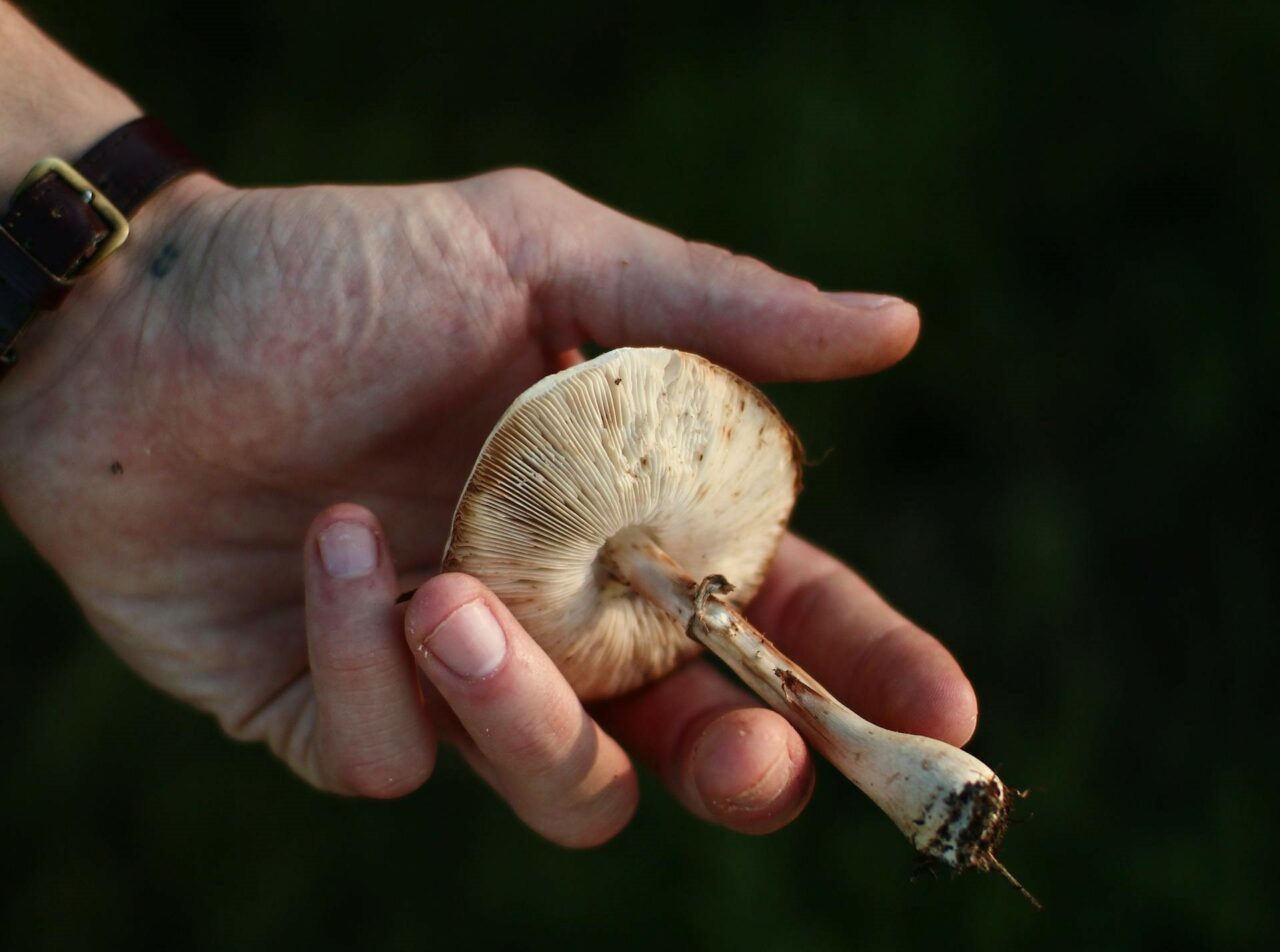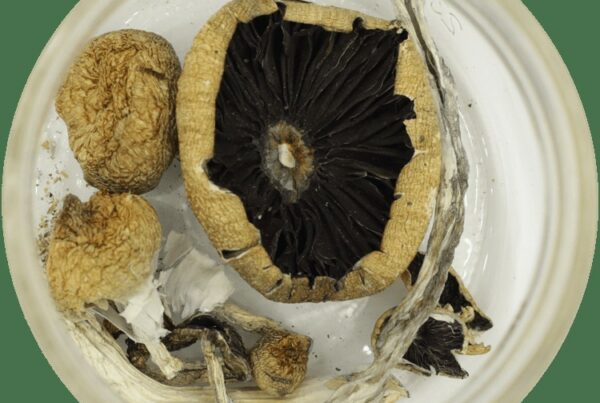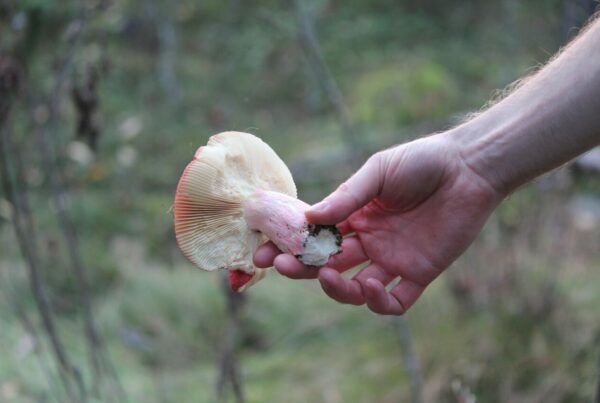Psilocybin mushrooms, traditionally considered a psychedelic, work as a serotonin 5-HT2A receptor agonist, much like LSD. Currently, research is being conducted on the use of psilocybin in therapeutic treatments for mental health disorders. These include major depression, anxiety, cluster headaches, and migraines that are associated with severe emotional distress.
In order to understand how shrooms can be beneficial in treating these conditions, it is vital to delve into their metabolic processes within the body. This insight allows both researchers and users to ascertain how the active compound triggers therapeutic and psychological effects. This article offers a basic introduction to psilocybin’s pharmacology and pharmacokinetics.
[toc]
Key Points:
- Half of the psychedelic fungi ingested orally gets absorbed and distributed across the body.
- The fungi compound is dephosphorylated by the enzyme alkaline phosphatase, primarily in the liver.
- Approximately 3.4% of the compound is expelled in its original form within 24 hours, with the rest being discharged as a stable metabolite.
What is Pharmacokinetics?
Pharmacokinetics (PK) is the study of how substances, such as drugs, are processed by the body once they enter the system. It is a distinct but related field to pharmacodynamics, which focuses on how a compound interacts with the body. PK explores four main facets: absorption, distribution, metabolism, and excretion (ADME).
By understanding these processes, healthcare professionals can prescribe the most effective medications with the least risk. They can also customize treatments to align with each patient’s unique physiology and lifestyle.
The Role of Pharmacokinetics in Psilocybin?
The key active compounds in certain species of magic mushrooms, psilocybin, and psilocin, have generated significant interest among researchers and users. Pharmacokinetics provides insight into how the body processes mushrooms that contain psilocybin, which can help understand their potential recreational or medicinal effects.
These compounds, also known as “magic,” “psychedelic,” “medicinal,” or “sacred,” are found in certain fungi that are ingestible. The mushroom species, their place of origin, size, growing and drying conditions, and age can significantly influence their potency.
Although these mushrooms naturally exist in the wild, scientists have devised techniques to produce them in a laboratory setting. Both naturally occurring and lab-grown versions display low toxicity, with minor side effects like nausea or vomiting sometimes experienced.
Despite these potential side effects, the compounds within these mushrooms are garnering attention for their potential therapeutic properties, due to their safety and non-addictive nature. This has spurred research into their use in psychotherapy, particularly for the treatment of anxiety and depression.
The 4 Phases of Pharmacokinetics
Psilocybin, the compound present in these mushrooms, is initially inactive and acts as a prodrug, converting into its active form, psilocin. Enzymes such as alkaline phosphatase facilitate this conversion, enabling psilocin to be absorbed and distributed throughout various body tissues. However, following oral consumption, psilocybin cannot be detected in the circulatory system, feces, or urine.
Absorption
Absorption is the process by which the compound enters the bloodstream from the site of administration. This impacts the speed and effectiveness with which the compound reaches its target, like plasma. Oral administration is the most common method of delivery. Inhalation has been tried but found to be less effective than ingestion.
The absorption process also involves the release of the compound from the dosage form during oral intake. Elements such as delays in the throat or esophagus can affect this process, possibly slowing down the effects or causing discomfort. Once the compound reaches the stomach, its acidic environment may start to degrade it before it is absorbed into the bloodstream.
Studies conducted on animals suggest that only approximately 50% of orally administered psychedelics are absorbed and distributed throughout the body.
Factors Affecting the Absorption Process
Several factors can influence the absorption process, leading to variations in onset, intensity, and duration:
- Stomach Contents: Consumption on a full stomach may delay the process as it slows down the onset of effects. Absorption is quicker on an empty stomach.
- Body Fat: Compounds may accumulate in fat tissues, which can potentially prolong their effects.
- Age: Metabolic rates and body composition usually vary with age.
- Zero-Order Kinetics: The substance is eliminated at a steady rate, regardless of its concentration.
- First-Order Kinetics: The elimination rate is proportional to the drug’s concentration.
Distribution in this context refers to how psilocin, once it enters the bloodstream, disperses throughout the body. Due to its lipophilic nature, psilocin can permeate the blood-brain barrier and reach the central nervous system.
Several factors, including the substance’s size, polarity, and protein-binding capacity, as well as an individual’s hydration status and body composition, significantly influence this distribution.
The aim is to achieve a potent concentration at the targeted location. The substance must not only reach the intended area—a factor determined by the volume of distribution—but also remain unattached to proteins, thus enabling active interaction with its receptor.
What Factors Influence the Distribution of Psilocin?
Several factors can affect the distribution process:
Typically, the effects begin to manifest between 20-40 minutes post-consumption, peaking at roughly 80-100 minutes. The effects of magic mushrooms generally last between 4-6 hours.
How is Psilocin Distributed to the Brain?
An early experimental research on two species showcased that its binding affinity sequence is 5HT2A > 5HT1A > 5HT2B [23]. It also binds to dopamine D1, 5HT1E, 5HT5A, 5HT7, 5HT6, D3, 5HT2C, and 5HT1B receptors.
At the 5HT2A receptor, psilocin acts as a partial agonist, exhibiting approximately 40% efficacy. The psychedelic effects are likely due to its partial agonist activity at 5HT1A autoreceptors.
The enhanced mood and psychotomimetic experiences can be linked to the rise in dopamine levels, which correlates with feelings of euphoria and depersonalization. Hallucinogens work by modifying neurochemistry and receptor activity. They enhance 5HT2A agonist activity, which in turn increases BDNF synthesis in the hippocampus, promoting neurogenesis and reducing conditioned fear-related behaviors.
How Psilocin is Excreted from the Body
Excretion refers to the process by which the The human body expels substances, mainly through the kidneys, but also through the lungs, skin, and gastrointestinal tract. In the context of kidneys, a naturally occurring psychedelic drug gets filtered through the glomerulus or secreted in the tubules, with some reabsorption adding complexity to the process.
The primary compound has a half-life of roughly 160 minutes, whereas psilocin’s half-life is about 50 minutes. Animal studies indicate that the majority of this substance is excreted in the urine, accounting for roughly 65% within 8 hours. Even after consumption, the substance can be detected in smaller amounts in bile and feces.
In the human body, about 3.4% of the substance is expelled in its initial form within a day, whereas the majority is shed as psilocin-O-glucuronide, a more stable by-product. This stability allows the compound to be detected in urine samples for a longer duration.
There are two main methods of substance expulsion:
Most psychedelic drugs adhere to the first-order kinetics method, reaching stable concentrations after four to five half-lives. Complete elimination also occurs after four to five half-lives.
Discover Our Range of Hallucinogenic Mushrooms
The metabolic process can vary across different mushroom types. By purchasing from reliable online vendors like Momentum Mushroom Canada, you can avoid inadvertently consuming poisonous mushrooms. Certain varieties, such as Agaric mushrooms, can provoke strong and undesirable effects. Therefore, sourcing magic mushrooms from trustworthy dispensaries is crucial, instead of risky street dealers or wild foraging.
| Feature | Enigma | Full Moon Party | Gold Member | |
| Strain Type | Psilocybe Cubensis OMNI | Psilocybe cubensis (Thai Koh Samui) | Psilocybe cubensis | |
| Potency | Exceptionally potent; 3.8% tryptamine content | Moderate to high potency | High potency | |
| Visual Characteristics | Resembles a blob or | Resembles a cauliflower or brain | Has a classic cubensis look; medium in size | Sturdy white stems; caps are a caramel-gold hue; visible blue bruising |
| Effects | Known as the most powerful; induces profound effects | Produces a heavy cerebral high; delayed onset but with vivid visuals | Causes intense visuals and euphoria |
Explore Psilocybin Mushroom Usage Online
For medical professionals, researchers, and users, understanding the pharmacokinetics of shrooms is essential. This knowledge allows you to make educated decisions regarding dosage and timing, thereby reducing potential risks.
Discover your perfect psychedelic experience at Momentum Mushroom Canada. Whether you desire a soothing journey or a deeper exploration, our extensive product selection is tailored to meet your unique needs. Enjoy top-quality, safe, and regulated shrooms without the worry of uncertain origins or poisonous mushrooms.
Sample the best magic mushrooms Canada has to offer and heighten your psychedelic experience to new heights.
Frequently Asked Questions
Do shrooms have any known interactions with other medicines?
Our products might interact with certain drugs, particularly those that affect serotonin levels, such as SSRIs (Selective Serotonin Reuptake Inhibitors). SSRIs and SNRIs (Serotonin and Norepinephrine Reuptake Inhibitors) tend to weaken the effects, unlike non-serotonergic antidepressants. This reduced effect can last up to three months after discontinuing the antidepressant.
Do all psychedelics operate in the same way as psilocybin?
No, each psychedelic compound has a unique structure that requires different metabolic processes to activate, and they connect to various receptors in the body. The absorption of each psychedelic is also affected by the method of administration. While the basic principles of absorption, metabolism, and distribution are consistent, the specific pathways and effects vary for each substance.
Can the shroom’s form affect its pharmacokinetics?
Yes, the form (be it fresh, powdered, or dried mushrooms) can influence the absorption rate. For example, powdered forms might be absorbed faster than whole dried ones due to quicker dissolution.
Suggested Further Reading:





